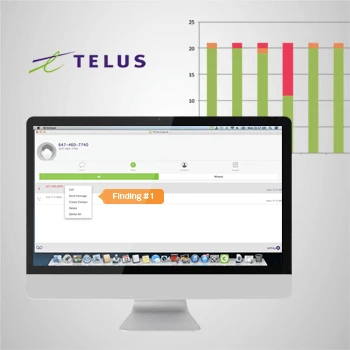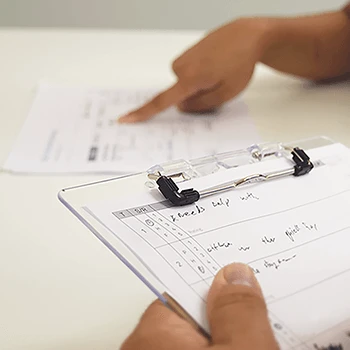What exactly is service concept testing and why should we consider it?
Service concept testing validates new service ideas with real customers before you invest in development. Through our Experience Thinking framework, we evaluate how your service concept performs across brand perception, content clarity, product functionality, and service delivery. This approach reveals whether customers will engage with your concept and identifies what needs refinement for success.
Tip: Test service concepts early in development when changes are still affordable and flexible rather than after significant investment has been made.
How does service concept testing differ from product concept testing?
Service concept testing examines multi-touchpoint experiences that often involve human interactions, while product testing focuses on tangible items. Services require validation of the entire customer journey, staff interactions, and support systems. The Experience Thinking service quadrant helps us understand how customers perceive the complete service ecosystem, not just individual features.
Tip: Consider the timing of service interactions and emotional responses throughout the customer journey when defining your testing approach.
What types of service concepts benefit most from testing?
New service offerings, service redesigns, and complex multi-step services gain the most value from concept testing. Services involving customer education, subscription models, or high-consideration purchases particularly benefit from validation. Foresight design principles help us anticipate how service concepts will perform as customer expectations evolve over time.
Tip: Focus concept testing on services where customer commitment is significant or where the learning curve affects adoption rates.
When in the development process should we conduct service concept testing?
Service concept testing works best after initial ideation but before detailed design and implementation. The Experience Thinking approach suggests testing concepts when you have enough definition to communicate the service vision but enough flexibility to make significant changes based on findings.
Tip: Plan concept testing when you can still modify core service elements without disrupting established timelines or commitments.
What makes a service concept ready for testing?
A testable service concept includes clear value proposition, basic service flow, key touchpoints, and preliminary resource requirements. Through Experience Thinking principles, we ensure the concept addresses brand alignment, content needs, product integration, and service delivery methods before testing begins.
Tip: Develop concepts to a level where participants can understand the service purpose and basic experience without requiring extensive explanation.
How do you handle testing for services that don't exist yet in the market?
Innovative services require creative testing approaches including scenarios, storyboards, and experiential prototypes. We use Experience Thinking content strategies to help participants understand new service concepts through familiar reference points and analogies. Foresight design methods help us anticipate how novel services might be received as markets mature.
Tip: Build understanding gradually by connecting new service concepts to existing experiences participants already know and value.
What's the difference between testing service concepts and testing service experiences?
Service concept testing evaluates the fundamental idea and value proposition before development, while service experience testing examines implemented services with real interactions. Concept testing explores 'will they want it' while experience testing asks 'does it work well.' Both are essential parts of the Experience Thinking lifecycle approach.
Tip: Use concept testing to validate direction before investing in service development, then follow with experience testing once the service is operational.
What research methods do you use for service concept testing?
We combine qualitative and quantitative methods including individual interviews, focus groups, concept validation surveys, and interactive prototyping sessions. The Experience Thinking framework guides our methodology selection based on which aspects of brand, content, product, and service experience need the most validation for your concept.
Tip: Balance emotional response research with functional feasibility testing to capture both desirability and usability aspects of service concepts.
How do you create realistic service concept presentations for testing?
We develop service concepts through multiple formats including service blueprints, customer journey visualizations, interactive prototypes, and scenario-based storyboards. Experience Thinking content principles ensure concepts are communicated clearly while maintaining the emotional and functional aspects participants need to evaluate accurately.
Tip: Present service concepts at a level of detail that allows meaningful feedback without overwhelming participants with complexity they won't encounter as actual customers.
What role does competitive analysis play in service concept testing?
Competitive analysis helps contextualize your service concept within the existing market landscape and identifies differentiation opportunities. We examine competitor services through the Experience Thinking lens to understand how your concept compares across brand positioning, content strategy, product integration, and service delivery approaches.
Tip: Include competitive context in testing to understand how participants position your concept relative to existing alternatives they know.
How do you recruit the right participants for service concept testing?
Participant recruitment focuses on your target customer segments, including both current customers and potential new audiences. We consider the complete Experience Thinking customer lifecycle, recruiting people at different stages from initial awareness through loyal advocacy to capture diverse perspectives on concept appeal.
Tip: Include participants who represent different levels of category experience to understand how concept clarity varies across your target audience.
What's your approach to testing service concepts across different customer segments?
We design testing protocols that reveal how different segments perceive and value service concepts. Experience Thinking recognizes that brand perception, content preferences, product needs, and service expectations vary significantly across customer types, requiring tailored testing approaches for meaningful insights.
Tip: Identify the core value proposition elements that must appeal to all segments versus features that can be customized for specific customer types.
How do you test service concepts that involve complex customer journeys?
Complex service concepts require journey-based testing that examines touchpoints, transitions, and cumulative experience over time. We use Experience Thinking lifecycle mapping to understand how concepts perform at different journey stages, from initial awareness through ongoing relationship management.
Tip: Break complex journeys into meaningful phases for testing while maintaining connection to the overall experience narrative.
What validation criteria do you use to evaluate service concept success?
Success criteria include customer appeal, differentiation strength, feasibility perception, and behavioral intent measures. The Experience Thinking framework helps establish criteria across brand resonance, content clarity, product integration potential, and service delivery viability to ensure concepts succeed holistically.
Tip: Establish success thresholds before testing begins to enable clear decision-making about concept direction based on findings.
How does service concept testing reduce business risk?
Testing reveals potential concept weaknesses before significant investment, identifies market readiness gaps, and validates customer demand assumptions. Experience Thinking risk assessment examines concept viability across brand fit, content requirements, product dependencies, and service delivery capabilities to prevent costly mistakes.
Tip: Quantify risk reduction by estimating the cost of concept modifications during testing versus post-launch corrections.
What ROI can we expect from investing in service concept testing?
ROI comes from avoiding failed service launches, accelerating successful concept development, and identifying high-value features early. Organizations typically see returns through reduced development costs, faster time-to-market for viable concepts, and improved service adoption rates when concepts are validated thoroughly.
Tip: Track both direct cost savings from avoided mistakes and revenue acceleration from validated concepts when calculating testing ROI.
How does testing help prioritize service concept features?
Testing reveals which concept elements drive customer interest and which create confusion or resistance. Through Experience Thinking analysis, we identify features that enhance brand perception, improve content understanding, strengthen product integration, and optimize service delivery efficiency.
Tip: Use testing insights to create a feature prioritization framework that balances customer value with implementation feasibility.
What business insights beyond concept validation do you typically uncover?
Testing often reveals market positioning opportunities, pricing sensitivity insights, communication strategy needs, and operational readiness gaps. The Experience Thinking perspective uncovers how concepts align with existing brand promises and where service delivery capabilities need development.
Tip: Plan testing to capture strategic insights about market readiness and competitive positioning alongside basic concept validation.
How do you measure the long-term impact of service concept decisions?
We establish measurement frameworks that track concept performance from initial testing through market launch and ongoing operation. Experience Thinking lifecycle metrics examine how validated concepts perform across customer acquisition, engagement, and retention phases.
Tip: Create measurement plans during concept testing that enable tracking of predicted versus actual performance once services are launched.
What's the cost of not testing service concepts before development?
Untested concepts risk market failure, require expensive post-launch modifications, and miss optimization opportunities that testing would reveal early. Experience Thinking analysis shows how concept weaknesses compound across brand reputation, content effectiveness, product integration, and service delivery quality.
Tip: Compare concept testing investment to the potential cost of service redesign, relaunch, or market withdrawal to justify testing budgets.
How does service concept testing impact go-to-market strategy?
Testing insights inform messaging strategy, channel selection, pricing approaches, and launch sequence decisions. Experience Thinking findings reveal how concepts should be positioned across brand channels, what content will resonate, how product integration should be communicated, and which service features to emphasize initially.
Tip: Use concept testing insights to develop differentiated go-to-market approaches for different customer segments identified during research.
How long does typical service concept testing take?
Testing duration depends on concept complexity and research scope, typically ranging from 2-8 weeks. Simple concepts may require only Design Steps of 1-2 days, while complex service ecosystems benefit from Design Sprints of 4-5 days or even Design Runs spanning 3-4 weeks for comprehensive validation.
Tip: Align testing timeline with your development schedule to ensure findings can influence concept refinement without delaying overall project timelines.
What factors influence the timeline for service concept testing?
Timeline factors include concept complexity, participant recruitment requirements, testing method selection, and stakeholder involvement needs. Experience Thinking assessment of brand, content, product, and service dimensions helps determine the appropriate testing scope and corresponding timeline.
Tip: Build timeline buffer for concept refinement and retesting if initial findings suggest significant modifications are needed.
Can service concept testing be done in parallel with other development activities?
Testing can run parallel with technical feasibility studies, competitive analysis, and preliminary design work that doesn't depend on customer validation. Experience Thinking coordination ensures testing insights inform concurrent activities without creating conflicting development directions.
Tip: Coordinate parallel activities to ensure testing findings can influence ongoing work without requiring significant rework.
How do you accommodate urgent testing timelines?
Accelerated testing uses streamlined methodologies, focused research questions, and efficient participant recruitment. Our Design Sprint approach can deliver meaningful concept validation within 4-5 days when timeline pressure requires rapid insights without sacrificing research quality.
Tip: Define the minimum viable insights needed for concept decisions to focus accelerated testing on the most critical validation questions.
What's the optimal timing for testing multiple service concept variations?
Multiple concepts can be tested sequentially for deep comparison or in parallel for efficiency. Experience Thinking evaluation considers how concept variations perform across brand consistency, content clarity, product integration, and service delivery feasibility to guide testing sequence decisions.
Tip: Test your strongest concept first to establish baseline performance, then evaluate variations against this standard.
How do you handle testing when service concepts are still evolving?
Iterative testing approaches accommodate evolving concepts through phased validation, rapid prototyping, and flexible research protocols. Design Tracks methodology supports ongoing concept development with multiple testing touchpoints that adapt to concept evolution.
Tip: Establish concept stability checkpoints to ensure testing insights remain relevant as concepts continue evolving.
What's the difference between Design Steps, Sprints, and Runs for concept testing?
Design Steps (1-2 days) handle focused validation questions, Design Sprints (4-5 days) provide comprehensive concept testing, while Design Runs (3-4 weeks) support complex service ecosystem validation. The choice depends on concept complexity and depth of insights needed for decision-making.
Tip: Start with Design Steps for initial concept validation, then progress to Sprints or Runs if concepts prove viable and need deeper investigation.
How involved should our internal stakeholders be in concept testing?
Stakeholder involvement includes research design input, observation participation, and insight interpretation sessions. Experience Thinking collaboration ensures stakeholders from brand, content, product, and service functions contribute their expertise while maintaining research objectivity throughout the testing process.
Tip: Balance stakeholder involvement to capture internal expertise while avoiding bias that could influence participant responses or insight interpretation.
What's the best way to present testing findings to different stakeholder groups?
Findings presentations are customized for audience needs - executives receive strategic summaries, product managers get tactical insights, and implementation teams receive operational guidance. Experience Thinking reporting ensures each stakeholder group understands concept implications for their functional area.
Tip: Prepare stakeholder-specific presentations that connect testing insights to each group's responsibilities and decision-making needs.
How do you manage conflicting stakeholder opinions about concept direction?
Testing data provides objective foundation for resolving stakeholder disagreements about concept direction. Experience Thinking analysis reveals how different perspectives align with customer needs across brand perception, content preferences, product functionality, and service delivery expectations.
Tip: Use customer voice from testing to refocus stakeholder discussions on market needs rather than internal preferences.
What role should customer-facing staff play in concept testing?
Customer-facing staff provide valuable insights about service feasibility, implementation challenges, and customer interaction patterns. Their Experience Thinking service delivery expertise helps interpret testing findings and identify operational considerations that affect concept viability.
Tip: Include frontline staff perspectives to ensure concept testing considers real-world service delivery constraints and opportunities.
How do you ensure testing insights translate into actionable recommendations?
Actionable recommendations connect testing insights to specific concept modifications, implementation priorities, and success metrics. Experience Thinking guidance addresses brand positioning, content strategy, product requirements, and service design changes needed based on customer feedback.
Tip: Document specific concept changes and implementation steps alongside research findings to facilitate rapid action on testing insights.
What's your approach to building stakeholder consensus around testing findings?
Consensus building uses collaborative analysis sessions, shared insight interpretation, and participatory planning for concept refinement. Experience Thinking facilitation helps stakeholders understand how testing findings impact their functional areas and contribute to unified concept development.
Tip: Create shared understanding through collaborative insight analysis rather than presenting findings as final conclusions.
How do you handle resistance to testing findings that challenge existing assumptions?
Resistance often stems from investment in existing approaches or concern about implementation challenges. We address resistance through evidence-based discussion, risk assessment of maintaining current direction, and collaborative exploration of how findings can be integrated practically.
Tip: Frame challenging findings as opportunities for competitive advantage rather than criticism of existing approaches.
How do testing insights translate into specific service design changes?
Testing insights inform service blueprints, customer journey modifications, touchpoint improvements, and interaction design changes. Experience Thinking implementation ensures changes align across brand expression, content strategy, product features, and service delivery methods for coherent customer experiences.
Tip: Prioritize concept changes that address the most significant customer concerns identified during testing.
What's your approach to retesting refined service concepts?
Refined concepts undergo focused retesting to validate improvements and identify any new issues introduced by changes. Iterative testing cycles use efficient methodologies to confirm concept enhancements without extensive timeline extension.
Tip: Focus retesting on the specific elements that were modified rather than repeating comprehensive testing of unchanged concept aspects.
How do you measure whether concept improvements actually work?
Improvement measurement compares refined concept performance against original testing benchmarks. Experience Thinking metrics track enhancement effectiveness across brand appeal, content clarity, product integration, and service delivery perception to ensure modifications achieve intended improvements.
Tip: Establish clear improvement targets during initial testing to enable objective assessment of concept refinement success.
What happens when testing reveals fundamental concept flaws?
Fundamental flaws trigger concept redesign or strategic pivot decisions based on testing insights. Experience Thinking analysis helps determine whether flaws can be addressed through modification or whether concepts need complete reconceptualization.
Tip: Treat fundamental flaws as valuable intelligence that prevents costly market failures rather than testing disappointments.
How do you support concept implementation after testing is complete?
Implementation support includes design guidance, success metric definition, and ongoing consultation as concepts move into development. Experience Thinking principles guide implementation to ensure final services maintain the validated concept appeal that testing confirmed.
Tip: Establish implementation checkpoints to ensure development maintains concept integrity identified through testing validation.
What tools do you provide for ongoing concept performance monitoring?
Monitoring tools include customer feedback frameworks, performance dashboards, and success metric tracking systems. Experience Thinking measurement approaches enable ongoing assessment of how implemented services perform against testing predictions.
Tip: Create monitoring systems during testing phase to enable seamless transition from concept validation to service performance tracking.
How do you help communicate concept changes to development teams?
Development communication includes detailed specifications, design rationale documentation, and collaborative handoff sessions. Experience Thinking change management ensures development teams understand not just what to build, but why specific features and interactions are critical for concept success.
Tip: Document the customer insights behind concept changes to help development teams make informed decisions when implementation challenges arise.
How is AI changing the landscape of service concept testing?
AI enhances testing through automated sentiment analysis, pattern recognition in customer feedback, and rapid prototype generation for concept exploration. However, human insight remains essential for understanding emotional responses and strategic implications that drive service concept success.
Tip: Use AI tools to augment testing analysis while maintaining human oversight for strategic interpretation and concept direction decisions.
What role does foresight design play in service concept development?
Foresight design anticipates how customer needs and service expectations will evolve, ensuring concepts remain relevant as markets change. Experience Thinking foresight examines future brand positioning, content consumption patterns, product integration possibilities, and service delivery innovations that could impact concept viability.
Tip: Consider how your service concept will perform not just today, but as customer behaviors and competitive landscapes evolve over time.
How do you test service concepts for emerging technologies?
Emerging technology concepts require specialized testing approaches including scenario modeling, technology adoption simulation, and early adopter feedback. Experience Thinking evaluation considers how new technologies integrate with brand strategy, content delivery, product ecosystems, and service operations.
Tip: Focus testing on value proposition clarity rather than technology features when evaluating concepts involving emerging technologies.
What considerations apply to testing international service concepts?
International testing addresses cultural adaptation needs, local market preferences, regulatory requirements, and operational feasibility across different regions. Experience Thinking global perspective examines how concepts translate across diverse brand perceptions, content preferences, product usage patterns, and service expectations.
Tip: Identify universal concept elements versus aspects that require local adaptation before designing international testing approaches.
How do you approach testing for subscription or recurring service concepts?
Subscription concepts require testing of onboarding experience, ongoing value perception, cancellation prevention, and loyalty building elements. Experience Thinking lifecycle analysis examines concept performance across customer journey phases from initial trial through long-term retention.
Tip: Test both initial appeal and sustained value perception to understand concept viability for subscription business models.
What's your approach to testing environmentally sustainable service concepts?
Sustainable service testing evaluates environmental benefit perception, behavior change requirements, and long-term adoption potential. Experience Thinking sustainability assessment considers how environmental values align with brand positioning, content messaging, product design, and service delivery methods.
Tip: Balance environmental benefits with practical usability to ensure sustainable concepts succeed with mainstream audiences.
How do you handle testing for highly regulated service concepts?
Regulated service testing incorporates compliance requirements, risk perception assessment, and trust building evaluation. Experience Thinking regulatory analysis ensures concepts meet customer needs while maintaining necessary compliance across brand communication, content accuracy, product safety, and service standards.
Tip: Involve regulatory and legal stakeholders early in testing design to ensure concept validation addresses compliance requirements alongside customer appeal.
What emerging trends should we consider when developing service concepts?
Key trends include personalization expectations, omnichannel integration, sustainability priorities, and technology-enabled convenience. Foresight design principles help anticipate how these trends will influence customer expectations and competitive landscapes affecting service concept viability.
Tip: Monitor trend adoption rates in your target market to time concept introduction when customer readiness aligns with concept innovation.
How do you ensure service concepts remain viable as customer expectations evolve?
Concept longevity requires built-in adaptability, ongoing customer feedback integration, and evolution planning. Experience Thinking future readiness examines concept flexibility across brand evolution, content adaptation, product integration, and service delivery innovation to maintain relevance over time.
Tip: Design service concepts with inherent flexibility that enables evolution rather than requiring complete redevelopment as markets change.












